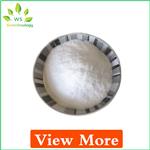- HEPES
-

- $0.00 / 1kg
-
2025-04-30
- CAS:7365-45-9
- Min. Order: 1kg
- Purity: 99%
- Supply Ability: 20MT
- HEPES
-

- $0.00 / 1Kg/Bag
-
2025-04-30
- CAS:7365-45-9
- Min. Order: 1KG
- Purity: 99.5%min
- Supply Ability: 1000KG
|
| | HEPES Chemical Properties |
| Melting point | 234-238 °C | | Boiling point | 408℃[at 101 325 Pa] | | bulk density | 560kg/m3 | | density | 1.07 g/mL at 20 °C | | vapor pressure | 0Pa at 25℃ | | refractive index | n20/D 1.339 | | storage temp. | 2-8°C | | solubility | H2O: 1 M at 20 °C, clear, colorless | | form | powder | | color | White | | PH | 5.0-6.5 (1Maqueous solution) | | pka | 7.5(at 25℃) | | PH Range | 7.0 - 7.6 | | biological source | synthetic | | Water Solubility | Soluble | | λmax | λ: 260 nm Amax: 0.06
λ: 280 nm Amax: 0.04 | | Merck | 14,4654 | | BRN | 883043 | | Stability: | Stable. Combustible. Incompatible with strong oxidizing agents. Protect from moisture. | | InChIKey | JKMHFZQWWAIEOD-UHFFFAOYSA-N | | LogP | -3.85 at 20℃ | | CAS DataBase Reference | 7365-45-9(CAS DataBase Reference) | | EPA Substance Registry System | 1-Piperazineethanesulfonic acid, 4-(2-hydroxyethyl)- (7365-45-9) | | Absorption | ≤0.05 at 290 in H2O at 33% |
| Hazard Codes | Xi | | Risk Statements | 36/37/38 | | Safety Statements | 24/25-22-36-26 | | WGK Germany | 1 | | RTECS | TL6809000 | | TSCA | Yes | | HS Code | 29335995 |
| | HEPES Usage And Synthesis |
| Description | HEPES has been described as one of the best all-purpose buffers available for biological research. At biological pH, the molecule is zwitterionic, and is effective as a buffer at pH 6.8 to 8.2 (pKa 7.55). It is typically used in cell culture at concentration between 5mM to 30 mM. HEPES has been used in a wide variety of applications, including tissue culture. It is commonly used to buffer cell culture media in air. HEPES finds its usage in in vitro experiments on Mg. | | Chemical Properties | White crystalline powder | | Uses | Non-toxic to cell. It is used as a hydrogen ion buffer, which can control the constant pH range for long term. The concentration is 10-50mmol/L. Generally, 20mmol/LHEPES in nutrient solution can get buffer ability. | | Uses | HEPES is common buffer for biological sciences, particularly used in cell culture to maintain physiological pH. It acts a buffering component, which is used in the preparation of buffers. It is described as one of the best all-purpose buffers available for use in biological research.
HEPES has been used as a component of:
Hank′s balanced salt solution, Dulbecco′s modified eagle′s medium and no-glucose DMEM, which are used for the preparation of tissue slices.
Buffers used in localized conductance measurements on the basolateral side of culture inserts to examine cation selectivity. | | Uses | HEPES is a biological buffer. It may be used in isoelectric focusing applications and as a buffer in the quantitative and selective measurement of antigen-antibody reactions. HEPES is reportedly superior to NaHCO3 in controlling pH in tissue and organ culture. HEPES is not recommended for use with the Folin-Ciocalteu protein assay. | | Definition | ChEBI: A HEPES that is ethanesulfonate substituted by a 4-(2-hydroxyethyl)piperazin-4-ium-1-yl group at position 2. | | General Description | HEPES buffered saline is a tissue culture buffer, which is used to maintain the pH of cell culture. It is water soluble and atmosphere independent. HEPES destroys magnesium in sodium chloride solutions. | | Biological Activity | Multi purpose buffer used in biological research. | | Biological Activity | HEPES is a multi purpose HEPES buffer used in cell culture and other biological research. Working pH range in aqueous solution: 6.8 - 8.2. Does not form complexes with metal ions. Used in cell culture media. | | storage | Room temperature | | Purification Methods | Crystallise the acid from hot EtOH and water. It is a useful buffer. [Beilstein 23 V 376.] |
| | HEPES Preparation Products And Raw materials |
|